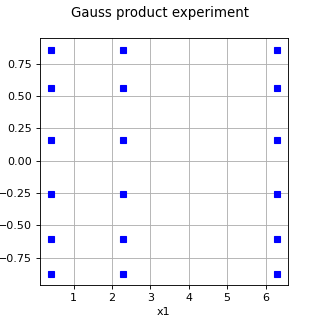GaussProductExperiment¶
(Source code, png, hires.png, pdf)

- class GaussProductExperiment(*args)¶
Gauss product experiment.
- Available constructors:
GaussProductExperiment(marginalSizes)
GaussProductExperiment(distribution)
GaussProductExperiment(distribution, marginalSizes)
- Parameters
- marginalSizessequence of positive int
Numbers of points
for each direction. Then, the total number of points generated is
. By default, the value of
is equal to
. The default marginal size is defined in the GaussProductExperiment-DefaultMarginalSize key of the
ResourceMap.- distribution :
Distribution
of dimension
with an independent copula.
See also
Notes
The Gauss product experiment is a tensor product experiment which uses Gauss points in each direction. Using the notations of the
TensorProductExperimentdocumentation, we haveand
for every index
.
For each marginal, the algorithm computes the family of orthogonal polynomials depending on the marginal distribution using the
StandardDistributionPolynomialFactoryclass. The input distribution must have an independent copula.Examples
>>> import openturns as ot >>> marginal_1 = ot.Exponential() >>> marginal_2 = ot.Triangular(-1.0, -0.5, 1.0) >>> distribution = ot.ComposedDistribution([marginal_1, marginal_2]) >>> marginalSizes = [3, 2] >>> experiment = ot.GaussProductExperiment(distribution, marginalSizes) >>> nodes, weights = experiment.generateWithWeights() >>> print(nodes) [ X0 X1 ] 0 : [ 0.415775 -0.511215 ] 1 : [ 2.29428 -0.511215 ] 2 : [ 6.28995 -0.511215 ] 3 : [ 0.415775 0.357369 ] 4 : [ 2.29428 0.357369 ] 5 : [ 6.28995 0.357369 ] >>> print(weights) [0.429018,0.168036,0.00626806,0.282075,0.110482,0.00412119]
In the following example [morokoff1995], we integrate a dimension 5 integrand with
marginal probability density functions. We use 7 nodes for each marginal, leading to a total of
nodes for the tensor product Gauss quadrature.
>>> import openturns as ot >>> def g_function_py(x): ... value = (1.0 + 1.0 / dimension) ** dimension ... for i in range(dimension): ... value *= x[i] ** (1.0 / dimension) ... return [value] >>> >>> dimension = 5 >>> g_function = ot.PythonFunction(dimension, 1, g_function_py) >>> interval = ot.Interval([0.0] * dimension, [1.0] * dimension) >>> integral = 1.0 >>> print('Exact integral = ', integral) Exact integral = 1.0 >>> marginal_levels = [7] * dimension >>> distribution = ot.ComposedDistribution([ot.Uniform(0.0, 1.0)] * dimension) >>> experiment = ot.GaussProductExperiment(distribution, marginal_levels) >>> nodes, weights = experiment.generateWithWeights() >>> number_of_nodes = nodes.getSize() >>> print('Number of nodes = ', number_of_nodes) Number of nodes = 16807 >>> function_values = g_function(nodes).asPoint() >>> approximate_integral = function_values.dot(weights) >>> print('Approximate integral = ', approximate_integral) Approximate integral = 1.0040...
Methods
generate()Generate points according to the type of the experiment.
Generate points and their associated weight according to the type of the experiment.
Accessor to the object's name.
Accessor to the distribution.
getId()Accessor to the object's id.
Get the marginal sizes.
getName()Accessor to the object's name.
Accessor to the object's shadowed id.
getSize()Accessor to the size of the generated sample.
Accessor to the object's visibility state.
hasName()Test if the object is named.
Ask whether the experiment has uniform weights.
Test if the object has a distinguishable name.
setDistribution(distribution)Accessor to the distribution.
setMarginalSizes(marginalSizes)Set the marginal sizes.
setName(name)Accessor to the object's name.
setShadowedId(id)Accessor to the object's shadowed id.
setSize(size)Accessor to the size of the generated sample.
setVisibility(visible)Accessor to the object's visibility state.
- __init__(*args)¶
- generate()¶
Generate points according to the type of the experiment.
- Returns
- sample
Sample Points
which constitute the design of experiments with
. The sampling method is defined by the nature of the weighted experiment.
- sample
Examples
>>> import openturns as ot >>> ot.RandomGenerator.SetSeed(0) >>> myExperiment = ot.MonteCarloExperiment(ot.Normal(2), 5) >>> sample = myExperiment.generate() >>> print(sample) [ X0 X1 ] 0 : [ 0.608202 -1.26617 ] 1 : [ -0.438266 1.20548 ] 2 : [ -2.18139 0.350042 ] 3 : [ -0.355007 1.43725 ] 4 : [ 0.810668 0.793156 ]
- generateWithWeights()¶
Generate points and their associated weight according to the type of the experiment.
- Returns
Examples
>>> import openturns as ot >>> ot.RandomGenerator.SetSeed(0) >>> myExperiment = ot.MonteCarloExperiment(ot.Normal(2), 5) >>> sample, weights = myExperiment.generateWithWeights() >>> print(sample) [ X0 X1 ] 0 : [ 0.608202 -1.26617 ] 1 : [ -0.438266 1.20548 ] 2 : [ -2.18139 0.350042 ] 3 : [ -0.355007 1.43725 ] 4 : [ 0.810668 0.793156 ] >>> print(weights) [0.2,0.2,0.2,0.2,0.2]
- getClassName()¶
Accessor to the object’s name.
- Returns
- class_namestr
The object class name (object.__class__.__name__).
- getDistribution()¶
Accessor to the distribution.
- Returns
- distribution
Distribution Distribution used to generate the set of input data.
- distribution
- getId()¶
Accessor to the object’s id.
- Returns
- idint
Internal unique identifier.
- getMarginalSizes()¶
Get the marginal sizes.
- Returns
- marginalSizes
Indices Numbers of points
for each direction.
- marginalSizes
- getName()¶
Accessor to the object’s name.
- Returns
- namestr
The name of the object.
- getShadowedId()¶
Accessor to the object’s shadowed id.
- Returns
- idint
Internal unique identifier.
- getSize()¶
Accessor to the size of the generated sample.
- Returns
- sizepositive int
Number
of points constituting the design of experiments.
- getVisibility()¶
Accessor to the object’s visibility state.
- Returns
- visiblebool
Visibility flag.
- hasName()¶
Test if the object is named.
- Returns
- hasNamebool
True if the name is not empty.
- hasUniformWeights()¶
Ask whether the experiment has uniform weights.
- Returns
- hasUniformWeightsbool
Whether the experiment has uniform weights.
- hasVisibleName()¶
Test if the object has a distinguishable name.
- Returns
- hasVisibleNamebool
True if the name is not empty and not the default one.
- setDistribution(distribution)¶
Accessor to the distribution.
- Parameters
- distribution
Distribution Distribution used to generate the set of input data.
- distribution
- setMarginalSizes(marginalSizes)¶
Set the marginal sizes.
- Parameters
- marginalSizessequence of positive int
Numbers of points
for each direction.
- setName(name)¶
Accessor to the object’s name.
- Parameters
- namestr
The name of the object.
- setShadowedId(id)¶
Accessor to the object’s shadowed id.
- Parameters
- idint
Internal unique identifier.
- setSize(size)¶
Accessor to the size of the generated sample.
- Parameters
- sizepositive int
Number
of points constituting the design of experiments.
- setVisibility(visible)¶
Accessor to the object’s visibility state.
- Parameters
- visiblebool
Visibility flag.
 OpenTURNS
OpenTURNS